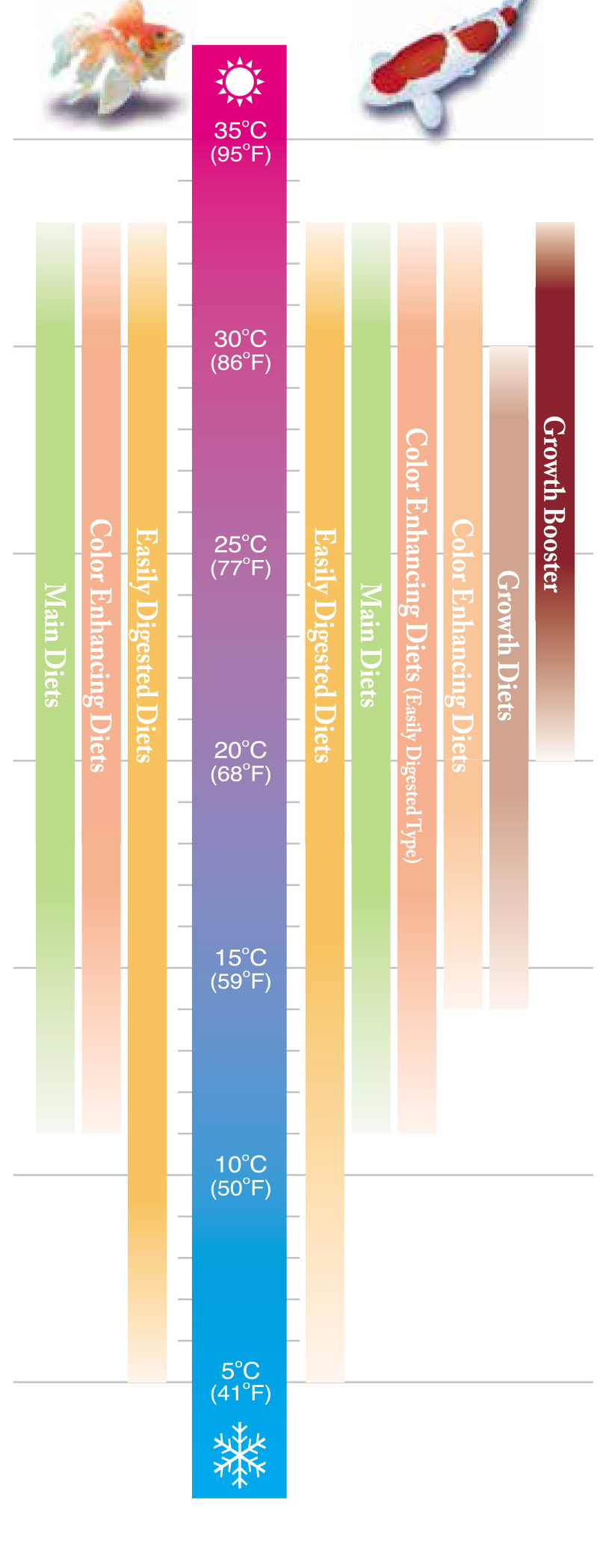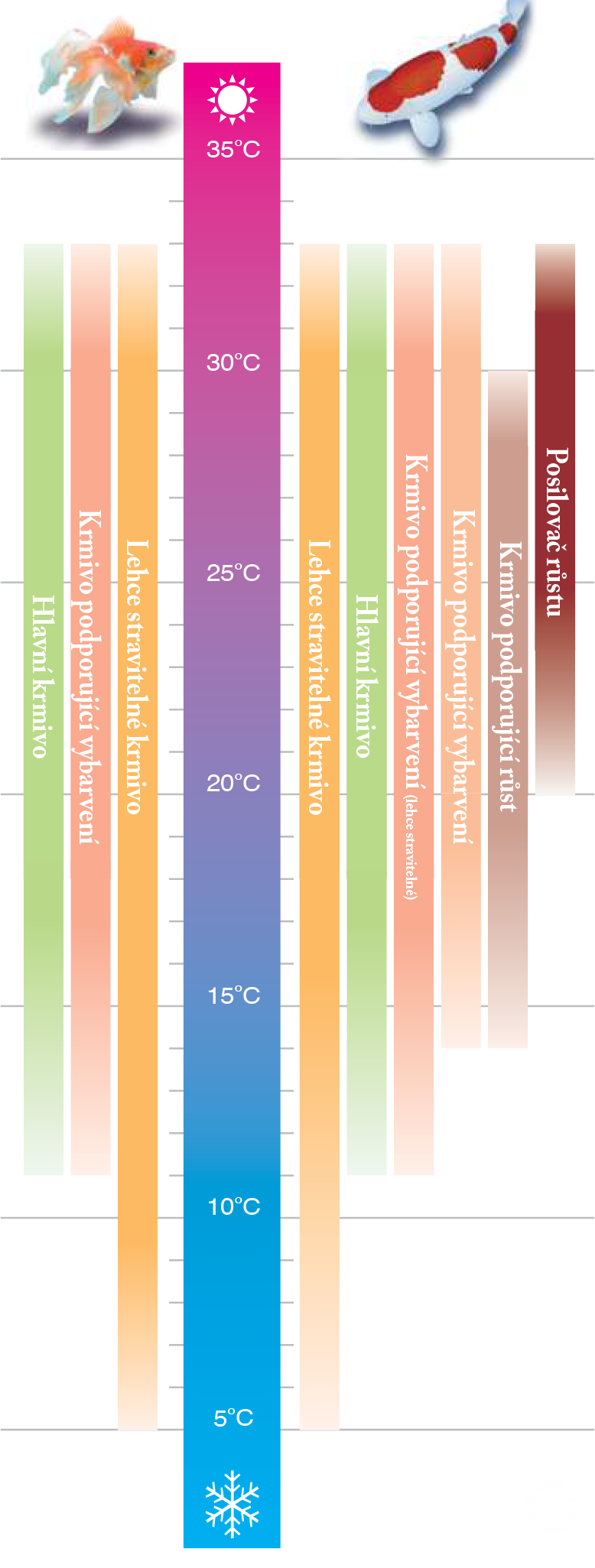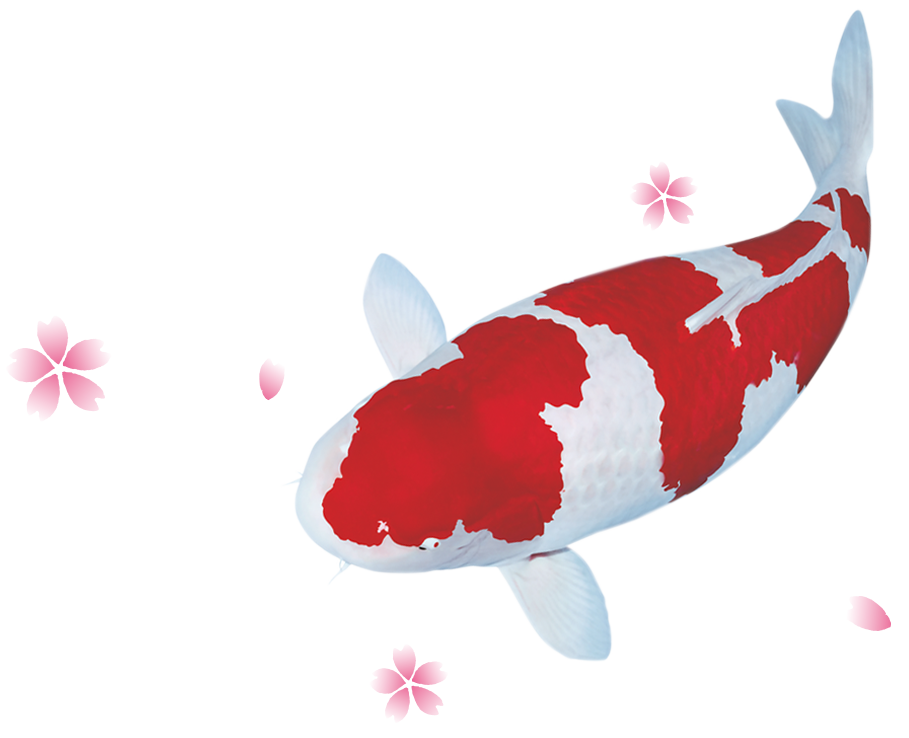Feeding cold water fish - the basics
Water temperature can dictate how and when you feed your fish. Great attention should also be paid to the state of the environment and the activity level of your fish. Consider your own knowledge and experience with fish!
Závojnatky
Over 30°C and higher
– Do not feed more than 2 times a day
Although goldfish are relatively strong during the summer season, they tire easily in warmer water. If your fish seem weak and lethargic, reduce the number of feedings and, if possible, lower the water temperature. Special attention should be paid to sudden changes in water temperature.
20-30°C
– Feed 2-4 times a day in smaller portions
Goldfish are most active in this temperature range. Feeds that promote coloring will help develop the natural beauty for which you bought them during this period. More frequent feeding in smaller doses will promote volume growth, while water quality is not negatively affected. Carefully monitor fish activity level and water quality before increasing feeding frequency and feed rate.
15-20°C
– Feed 2-4 times a day
Goldfish digest food very easily at this temperature. You can feed them the food of your choice as often as you need. During periods of sudden changes in water temperature, reduce the number of doses (no more than 2 times a day.)
10-15°C
– Feed 1-2 times a day
As the metabolism of your fish slows down, the level of activity also decreases, which is the first sign for you to reduce the feed dose. If the water temperature is in this range, feed an easily digestible food such as Hikari Wheat-Germ. Try to feed
in the hottest part of the day, you will prevent digestive problems.
5-10°C
– Do not feed more than 2-3 times a week
If the water temperature is in this range, always use an easily digestible food such as Hikari Wheat-Germ, while carefully monitoring the condition of your fish. If your fish stop showing interest, stop feeding immediately. For best results, feed between 10-14. an hour.
Under 5°C
– Stop feeding
Your goldfish should now be in hibernation mode and feeding is not necessary.

Koi
Over 30°C and higher
– Do not feed more than 2 times a day (no more than 4 times a day for small Koi)
At higher water temperatures, Koi lose their appetite for feeding. If your fish are in good condition, feed smaller portions of easily digestible feed. Try to reduce the water temperature by shading it from direct sunlight. Small Koi are less affected by higher temperatures and can be fed more often with a smaller feed ration.
20-30°C
– Feed 2-4 times a day in smaller portions
Koi are most active in this temperature range. You can feed as often as you want with food that supports coloring or growth, or with standard food. More frequent feeding with smaller portions leads to a faster increase in the weight and volume of the fish. Always monitor water quality and activity level when deciding on ration size. Always avoid feeding one hour after sunset and sunrise.
15-20°C
– Feed 1-2 times a day
In this temperature range, carefully monitor the activity level of your pets. As the water temperature decreases, the digestive efficiency of your Koi also decreases. Special attention should be paid to feeding rations, do not overfeed and do not offer feed during periods of inactivity. If the water temperature is not stable, feed in the warmer part of the day.
10-15°C
– Do not feed more than 2 times a day
If the water temperature drops like this, carefully monitor the activity of your Koi and do not feed them unless they really show interest. Use only easily digestible feeds such as Hikari Wheat-Germ. Try to feed if possible between 10am and 2pm, when it is the warmest.
5-10°C
– Do not feed more than 2-3 times a week
If the water temperature drops like this, you can stop feeding until spring. If your Koi are active, you can feed them a dose that they will consume within about a minute, but no more. Always try to feed between 10am and 2pm when it is the warmest.
Under 5°C
– Stop feeding
Your Koi should be in hibernation mode and feeding is not necessary.
Easily digestible feed
- The values of the indicated temperatures are indicative only. You yourself know the eating habits of your fish and the condition of your pond best. If you encounter difficulties using the above guide, contact a local specialist to help you prepare a program for your specific situation.
Easily digestible feed
Growth booster
Growth boosting feed
Goldfish
Over 30°C and higher
– Do not feed more than 2 times a day
Although goldfish are relatively strong during the summer season, they tire easily in warmer water. If your fish seem weak and lethargic, reduce the number of feedings and, if possible, lower the water temperature. Special attention should be paid to sudden changes in water temperature.
20-30°C
– Feed 2-4 times a day in smaller portions
Goldfish are most active in this temperature range. Feeds that promote coloring will help develop the natural beauty for which you bought them during this period. More frequent feeding in smaller doses will promote volume growth, while water quality is not negatively affected. Carefully monitor fish activity level and water quality before increasing feeding frequency and feed rate.
15-20°C
– Feed 2-4 times a day
Goldfish digest food very easily at this temperature. You can feed them the food of your choice as often as you need. During periods of sudden changes in water temperature, reduce the number of doses (no more than 2 times a day.)
10-15°C
– Feed 1-2 times a day
As the metabolism of your fish slows down, the level of activity also decreases, which is the first sign for you to reduce the feed dose. If the water temperature is in this range, feed an easily digestible food such as Hikari Wheat-Germ. Try to feed in the hottest part of the day, you will prevent digestive problems.
5-10°C
– Do not feed more than 2-3 times a week
If the water temperature is in this range, always use an easily digestible food such as Hikari Wheat-Germ, while carefully monitoring the condition of your fish. If your fish stop showing interest, stop feeding immediately. For best results, feed between 10-14. an hour.
Under 5°C
– Stop feeding
Your goldfish should now be in hibernation mode and feeding is not necessary.

Easily digestible feed

Koi
Over 30°C and higher
– Do not feed more than 2 times a day (no more than 4 times a day for small Koi)
At higher water temperatures, Koi lose their appetite for feeding. If your fish are in good condition, feed smaller portions of easily digestible feed. Try to reduce the water temperature by shading it from direct sunlight. Small Koi are less affected by higher temperatures and can be fed more often with a smaller feed ration.
20-30°C
– Feed 2-4 times a day in smaller portions
Koi are most active in this temperature range. You can feed as often as you want with food that supports coloring or growth, or with standard food. More frequent feeding with smaller portions leads to a faster increase in the weight and volume of the fish. Always monitor water quality and activity level when deciding on ration size. Always avoid feeding one hour after sunset and sunrise.
15-20°C
– Feed 1-2 times a day
In this temperature range, carefully monitor the activity level of your pets. As the water temperature decreases, the digestive efficiency of your Koi also decreases. Special attention should be paid to feeding rations, do not overfeed and do not offer feed during periods of inactivity. If the water temperature is not stable, feed in the warmer part of the day.
10-15°C
– Do not feed more than 2 times a day
If the water temperature drops like this, carefully monitor the activity of your Koi and do not feed them unless they really show interest. Use only easily digestible feeds such as Hikari Wheat-Germ. Try to feed if possible between 10am and 2pm, when it is the warmest.
5-10°C
– Do not feed more than 2-3 times a week
If the water temperature drops like this, you can stop feeding until spring. If your Koi are active, you can feed them a dose that they will consume within about a minute, but no more. Always try to feed between 10am and 2pm when it is the warmest.
Pod 5°C
– Stop feeding
Your Koi should be in hibernation mode and feeding is not necessary.
Easily digestible feed
Growth booster
Growth boosting feed
- The values of the indicated temperatures are indicative only. You yourself know the eating habits of your fish and the condition of your pond best. If you encounter difficulties using the above guide, contact a local specialist to help you prepare a program for your specific situation.
Never overfeed! Remember, feeding less is always better than feeding too much!
- Always check the ration to ensure no residue remains. If there is food left in the water after feeding, remove it immediately to prevent water quality problems.
- In the new environment and conditions, reduce the feed rate until your filter system completes the first cycle and creates a suitable bacterial environment.
- If something unusual happens (sudden change in water temperature, unstable water quality, or disease), you should stop feeding completely or reduce the feed rate until the condition returns to normal.
- Special attention is in order during the spring when you start the feeding cycle again. Use only easily digestible feeds such as Hikari Wheat-Germ, gradually increase the feeding dose until the amount is completely suitable for your situation. This will help your fish to effectively restore their digestive process, and the likelihood of disease will also decrease.
Závojnatky
Přes 30°C a vyšší
djf sdfkl sjfůskdj fsdůkfj sdůfkj fksdjf ksdjf ůakjf ůkjfd kjafkljs ůdkjfů a
20-30°C
djf sdfkl sjfůskdj fsdůkfj sdůfkj fksdjf ksdjf ůakjf ůkjfd kjafkljs ůdkjfů a
15-20°C
djf sdfkl sjfůskdj fsdůkfj sdůfkj fksdjf ksdjf ůakjf ůkjfd kjafkljs ůdkjfů a
10-15°C
djf sdfkl sjfůskdj fsdůkfj sdůfkj fksdjf ksdjf ůakjf ůkjfd kjafkljs ůdkjfů a
5-10°C
djf sdfkl sjfůskdj fsdůkfj sdůfkj fksdjf ksdjf ůakjf ůkjfd kjafkljs ůdkjfů a
Pod 5°C
djf sdfkl sjfůskdj fsdůkfj sdůfkj fksdjf ksdjf ůakjf ůkjfd kjafkljs ůdkjfů a

Growth booster
Krmivo podporující růst
Krmivo podporující vybarvení
Krmivo podporující vybarvení lehce stravitelné
Hlavní krmivo
Lehce stranitelné krmivo
Lehce stravitelné krmivo
Krmivo podporující vybarvení
Hlavní krmivo
Koi
Přes 30°C a vyšší
djf sdfkl sjfůskdj fsdůkfj sdůfkj fksdjf ksdjf ůakjf ůkjfd kjafkljs ůdkjfů a
20-30°C
djf sdfkl sjfůskdj fsdůkfj sdůfkj fksdjf ksdjf ůakjf ůkjfd kjafkljs ůdkjfů a
15-20°C
djf sdfkl sjfůskdj fsdůkfj sdůfkj fksdjf ksdjf ůakjf ůkjfd kjafkljs ůdkjfů a
10-15°C
djf sdfkl sjfůskdj fsdůkfj sdůfkj fksdjf ksdjf ůakjf ůkjfd kjafkljs ůdkjfů a
5-10°C
djf sdfkl sjfůskdj fsdůkfj sdůfkj fksdjf ksdjf ůakjf ůkjfd kjafkljs ůdkjfů a
Pod 5°C
djf sdfkl sjfůskdj fsdůkfj sdůfkj fksdjf ksdjf ůakjf ůkjfd kjafkljs ůdkjfů a








